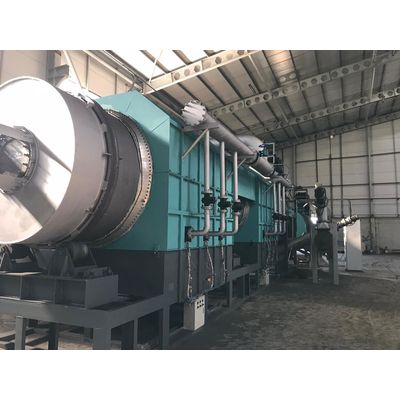

- Home
- Companies
- Beston Group Co., Ltd.
- Articles
- How Can Biochar Production Equipment ...

How Can Biochar Production Equipment Revolutionize Soil Remediation?
In the ever-evolving realm of environmental science, the quest for sustainable and efficient soil remediation techniques is relentless. One innovative solution that has been steadily gaining prominence is the utilization of biochar production equipment. Biochar, often referred to as "black gold" due to its remarkable potential, is a carbon-rich substance derived from organic materials like wood, agricultural residues, and even algae. Its ability to boost soil health and mitigate pollution makes it a compelling choice for restoring and enhancing degraded soils.
What is Biochar?
Biochar is not your run-of-the-mill carbonaceous material. It undergoes a meticulous production process that distinguishes it from other carbon-rich substances like charcoal. When biomass is subjected to pyrolysis, a high-temperature, low-oxygen decomposition process, the result is biochar. This complex matrix of carbon-rich molecules possesses extraordinary adsorption capacity, thanks to its porous structure. These microscopic pores are the key to its effectiveness in soil remediation.
Biochar's Role in Soil Remediation
The intricate architecture of biochar is a boon for soil remediation. Its exceptional surface area and porosity enable it to sequester heavy metals, organic pollutants, and other contaminants in soil. This adsorption capacity ensures that pollutants are effectively immobilized, preventing their migration to groundwater and the wider environment. In this sense, biochar acts as a formidable guardian against soil contamination.
Furthermore, biochar's introduction to soil significantly enhances its nutrient-retention capabilities. It serves as a sanctuary for essential nutrients, preventing them from being washed away by rainfall or leached by irrigation. This quality is particularly invaluable in agriculture, where nutrient loss is a persistent concern. Biochar's ability to reduce nutrient leaching promotes sustainable farming practices and can even lead to increased crop yields.
The Biochar Production Process
Before biochar can work its magic in soil remediation, it must first undergo a meticulous production process. This process not only ensures the creation of high-quality biochar but also maximizes its adsorption and nutrient-retention properties. Here are the key steps involved in biochar production:
- Feedstock Selection: The choice of feedstock is pivotal in determining the biochar's properties. Different feedstocks can result in biochars with varying characteristics. Wood, crop residues, and even algae can be used.
- Pyrolysis: This is the heart of the biochar production process. The feedstock is subjected to high temperatures in a controlled environment with limited oxygen. The absence of oxygen during pyrolysis is crucial as it prevents complete combustion and results in the formation of biochar rather than ash.
- Activation: While pyrolysis is essential for biochar formation, additional activation steps can further enhance its properties. Activation methods include steam activation and chemical activation, which can boost its adsorption capacity.
- Particle Size Reduction: The biochar is then ground into smaller particles, which increases its surface area and makes it more effective in soil remediation.
Quality Control: Quality control measures, including testing for contaminants, are essential to ensure that the final product meets the required standards.
Applications of Biochar in Soil Remediation
Biochar's multifaceted properties have led to its successful application in a wide range of soil remediation scenarios. Here are some noteworthy applications:
- Contaminated Land Remediation: In areas contaminated with heavy metals, petrochemicals, or other toxic substances, biochar acts as a sponge, absorbing these pollutants and preventing their spread.
- Agricultural Soil Improvement: In agriculture, biochar enhances soil fertility and structure, leading to improved crop yields and reduced reliance on chemical fertilizers.
- Urban Green Spaces: Biochar can revitalize urban green spaces by improving soil quality, which is often degraded due to pollution and compaction.
- Stormwater Filtration: Biochar is used in stormwater management systems to filter and capture pollutants, ensuring that runoff water is cleaner before entering natural water bodies.
- Wastewater Treatment: In wastewater treatment, biochar can adsorb organic contaminants, heavy metals, and nutrients, making the treatment process more efficient.
Biochar Production Equipment: The Enabler of Sustainable Soil Remediation
The increased recognition of biochar's potential has driven innovations in biochar production equipment. These specialized tools and systems have been pivotal in making biochar production more efficient, cost-effective, and environmentally friendly.
Some key aspects of modern biochar production equipment include:
- Continuous Feed Systems: These systems allow for a steady input of feedstock, resulting in a continuous output of biochar. This is a marked improvement over batch processes and ensures a more consistent product.
- Efficient Heat Recovery: Many modern biochar production equipment systems are designed to capture and reuse the heat generated during pyrolysis, reducing energy consumption and carbon emissions.
- Emission Control: Advanced biochar production equipment includes emission control systems that capture and treat volatile organic compounds and other pollutants produced during the pyrolysis process, reducing environmental impact.
- Customization: Biochar production equipment can be tailored to suit different feedstocks and production scales, ensuring flexibility in application.
- Automation: The integration of automation and control systems simplifies the production process, making it more accessible to a wider range of users.
